ND Filters: Mounted, AR Coated for 350 - 700 nm
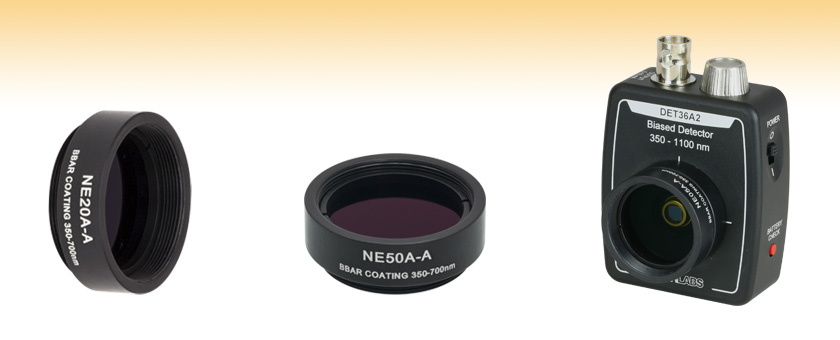
- Mounted Ø25 mm Round Filter
- Optical Densities Ranging from 0.1 to 6.0
- Ideal for Low-Power Applications (<1 W)
NE20A-A
NE50A-A
NE05A-A Mounted
in a DET36A2 Detector
Application Idea

Please Wait
| Neutral Density Filter Selection Guide | |
|---|---|
| Absorptive | |
| Uncoated (400 - 650 nm) |
Mounted |
| Unmounted | |
| Uncoated (1000 - 2600 nm) |
Mounted |
| Unmounted | |
| AR Coated (350 - 700 nm) |
Mounted |
| Unmounted | |
| AR Coated (650 - 1050 nm) |
Mounted |
| Unmounted | |
| AR Coated (1050 - 1700 nm) |
Mounted |
| Unmounted | |
| Variable | |
| Reflective | |
| UV Fused Silica (200 - 1200 nm) |
Mounted |
| Unmounted | |
| N-BK7 (350 - 1100 nm) |
Mounted |
| Unmounted | |
| ZnSe (2 - 16 µm) |
Mounted |
| Unmounted | |
| Wedged UVFS (200 - 1200 nm) |
|
| Wedged N-BK7 (350 - 1100 nm) |
|
| Wedged ZnSe (2 - 16 µm) |
|
| Variable | |
| Neutral Density Filter Kits | |

Click to Enlarge
ND Filters Being Ground at Our Optics Manufacturing Facility
Features
- Attenuate Light in the Visible (350 - 700 nm AR Coating)
- Optical Densities Ranging from 0.1 to 6.0
- Mounted Ø25 mm Round Filters
- AR Coated to Reduce Back Reflections in an Optical System
- Ideal for Low-Power Applications (<1 Watt)
- Engraved with Coating Range and Part Number
Thorlabs is pleased to offer its most popular mounted absorptive neutral density filters with a broadband antireflection coating for the 350 - 700 nm range deposited on both surfaces. The high-performance, multilayer broadband A coating deposited on each filter is designed to minimize surface reflections within the 350 - 700 nm range, thereby reducing the amount of stray light present. These coatings provide an average reflectance that is less than 0.5% over the specified wavelength range when light is normally incident on the filter surface. Typical filter transmission data is available by clicking on the blue info icons (![]() ) in the tables below.
) in the tables below.
These filters are mounted in engraved SM1L03 Ø1" lens tubes, which are compatible with a wide range of rigid optomechanical parts such as our cage systems and lens tubes. If desired, a mounted filter can be removed from its housing by unscrewing the retaining ring that secures the filter to the mount. Thorlabs offers a range of spanner wrenches that are an ideal match to these retaining rings. These filters are also available unmounted. The equivalent unmounted filter is listed in the drawing for each mounted filter, accessible through the red docs icons (![]() ) below. Please see the Selection Guide table to the right for all neutral density filter options.
) below. Please see the Selection Guide table to the right for all neutral density filter options.
Unlike metallic neutral density filters, each absorptive ND filter is fabricated from one member of a family of Schott glasses (see the Specs tab for more information). Each Schott glass has a spectrally flat absorption coefficient. By varying the type of glass used and the thickness of that glass, we are able to produce our entire line of absorptive ND filters from just four types of Schott glass. See below for detailed information about the average transmission obtained with each of our AR-coated absorptive neutral density filters.
Optical Density and Transmission
Optical density (OD) indicates the attenuation factor provided by an optical filter, i.e. how much it reduces the optical power of an incident beam. OD is related to the transmission, T, by the equation

where T is a value between 0 and 1. Choosing an ND filter with a higher optical density will translate to lower transmission and greater absorption of the incident light. For higher transmission and less absorption, a lower optical density would be appropriate. As an example, if a filter with an OD of 2 results in a transmission value of 0.01, this means the filter attenuates the beam to 1% of the incident power. Please note that the transmission data for our neutral density filters is provided in percent (%).
Please note that these products are not designed for use as laser safety equipment. For lab safety, Thorlabs offers an extensive line of safety and blackout products, including beam blocks, that significantly reduce exposure to stray light.
| Optical Density (OD)a | OD Tolerancea | Substrate | Substrate Thicknessb |
|---|---|---|---|
| 0.1 | ±0.01 | NG11 | 0.6 mm |
| 0.2 | ±0.01 | NG11 | 1.4 mm |
| 0.3 | ±0.015 | NG11 | 2.3 mm |
| 0.4 | ±0.02 | NG4 | 0.7 mm |
| 0.5 | ±0.025 | NG4 | 0.9 mm |
| 0.6 | ±0.03 | NG4 | 1.1 mm |
| 0.7 | ±0.04 | NG4 | 1.3 mm |
| 0.8 | ±0.05 | NG4 | 1.5 mm |
| 0.9 | ±0.05 | NG4 | 1.7 mm |
| 1.0 | ±0.05 | NG4 | 1.9 mm |
| 1.3 | ±0.065 | NG4 | 2.5 mm |
| 1.5 | ±0.08 | NG4 | 2.9 mm |
| 2.0 | ±0.1 | NG9 | 1.4 mm |
| 3.0 | ±0.15 | NG9 | 2.1 mm |
| 4.0 | ±0.2 | NG9 | 2.8 mm |
| 5.0 | ±0.25 | NG9 | 3.6 mm |
| 6.0 | ±0.3 | NG1 | 1.5 mm |
| General Specifications | ||
|---|---|---|
| Diameter | 25.0 mm | |
| Diameter Tolerance | +0.00 / -0.25 mm | |
| Clear Aperture | >Ø20.0 mm | |
| AR Coating Range | 350 - 700 nm | |
| Reflectance (Average) | <0.5% per Surfacea | |
| Surface Quality | 60-40 Scratch-Dig | |
| Transmitted Wavefront Error (TWE) | <λ/4 (@ 633 nm) | |

Click to Enlarge
Click Here for Raw Data
The blue shaded region indicates the specified 350 - 700 nm wavelength range for optimum performance.
The shaded regions in the graphs below denote the wavelength range for which the AR coating performance is specified. Click here to download optical density and transmission data. For the transmission and optical density of a particular filter, please click ![]() in the row corresponding to the filter in the tables below.
in the row corresponding to the filter in the tables below.

Click to Enlarge
Click Here for Raw Data
The blue shaded region indicates the specified 350 - 700 nm wavelength range for optimum performance.
| Posted Comments: | |
Richard Anderson
(posted 2022-03-16 09:29:03.94) I have a NE03A-A that I would like to use in a high-temperature environment. Could you please inform me of what is the maximum direct-contact temperature that model of filter can be subjected to without damage? cdolbashian
(posted 2022-03-25 11:40:49.0) Thank you for reaching out to us with this inquiry Richard. As it is listed on the "Specs" tab of the product page above, this is SCHOTT NG11 glass. We mount this filter within an anodized aluminum housing. In terms of critical temperatures, we have the following information to provide. The aluminum has a melting point >582°C, the glass transition temperature of the SCHOTT NG11 is 481°C, and we have observed our anodization will begin to strip from the aluminum between 100-135°C. I have contacted you directly to discuss your application further. Ju Fe
(posted 2020-10-12 10:50:58.603) Hello Thorlabs,
In the excel files, a message says "Slight variations in performance data will occur from lot to lot".
Could you estimate the uncertainty on the transmission curves ?
Best Regards,
Julien asundararaj
(posted 2020-10-26 04:16:00.0) Thank you for contacting Thorlabs. The variation in the performance is a result of the tolerance on the thickness of the ND filter as well as the the variation in the AR coating. The tolerance in the thickness is ±0.2 mm and the variation n the AR coating is less than 1% and is detailed in this link - ttps://www.thorlabs.com/newgrouppage9.cfm?objectgroup_id=5840&tabname=AR%20coating Hailong He
(posted 2020-05-07 10:22:37.33) Hi,
I am interested in the ND filter at wavelenght of 532 nm. I would like to ask the damage threshold of them. I am using a pulse laser (2 ns) with maximum peak power of 200KW. Is this power in the safe range of the density filters?
Thanks,
Hailong YLohia
(posted 2020-05-08 08:39:05.0) Hello Hailong, thank you for contacting Thorlabs. These filters are designed for < 1 W CW applications. Unfortunately, we do not expect these filters to perform well for your 2 ns, 1 kHz, 200 kW peak power pulses at 532 nm. Instead, we recommend looking into our uncoated absorptive ND filters on this page : https://www.thorlabs.us/newgrouppage9.cfm?objectgroup_id=266. Ali Ojaghloo
(posted 2020-04-28 00:39:38.007) dear services,
I have some of your company product such as ND filter, Photodiode, lenses and etc.
unfortunately in user manual and your website information about these damage threshold not anything.
please give me some inform about it to calculate max power that we can use?
I have NEIR 40A-c, NE 40A-A,
i have about ten models of photodiode of your products such DET10A/M which you don't mentioned about asundararaj
(posted 2020-05-04 05:08:57.0) Thank you for contacting Thorlabs. While we do not have an official spec for the damage threshold for the NE40A-A and the NEIR40A-C, I have contacted you directly to see if these would suit your application.
As for the DET10A/M, while we typically do not spec a damage threshold for our detectors, the power is limited by the max reverse current on the photodiode - 5 mA. The Max optical power can be found from the responsivity at your wavelength using the following equation,
Maximum Optical Power (in W) = Maximum PhotoCurrent (in A) * Responsivity (in A/W) user
(posted 2020-04-26 21:05:31.333) Is there an LIDT for the ND filters? YLohia
(posted 2020-04-27 10:50:16.0) Thank you for contacting Thorlabs. These filters are designed for applications with < 1 W power. I have reached out to you directly to offer suggestions based on your specific requirements. Aeckford
(posted 2014-09-25 15:39:56.333) Why dont these have a slight angle on them to improve performance in stacked usage? besembeson
(posted 2014-10-09 02:13:21.0) Response from Bweh at Thorlabs. I believe you are concerned about interference effects due to reflections from multiple parallel surfaces in your application? We are designing new wedged reflective ND filters to eliminate such effects. If your need is immediate, we can apply a reflective ND coating (with appropriate OD) on a wedged window as a special. jlow
(posted 2012-12-11 16:32:00.0) Response from Jeremy at Thorlabs: Thank you for pointing this error out to us. We will rescan this and put the correct version up on the website. rschoeneck
(posted 2012-12-07 11:10:58.287) The transmission graph and raw data listed for the NE05A-A OD 0.5 ND filter show values that match an OD 0.3 filter. Probably the wrong element was used to generate the OD 0.5 transmission curve. |
 Products Home
Products Home












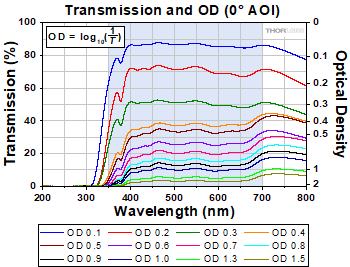
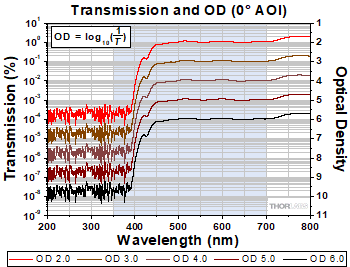
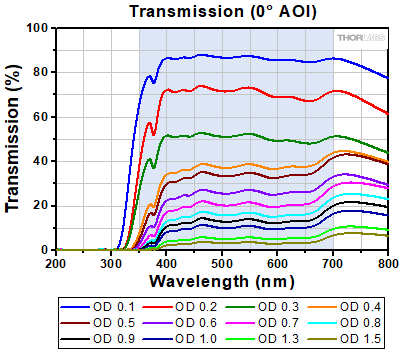

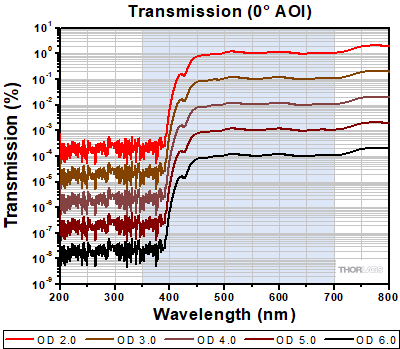


 Mounted Absorptive ND Filters (A Coated)
Mounted Absorptive ND Filters (A Coated)